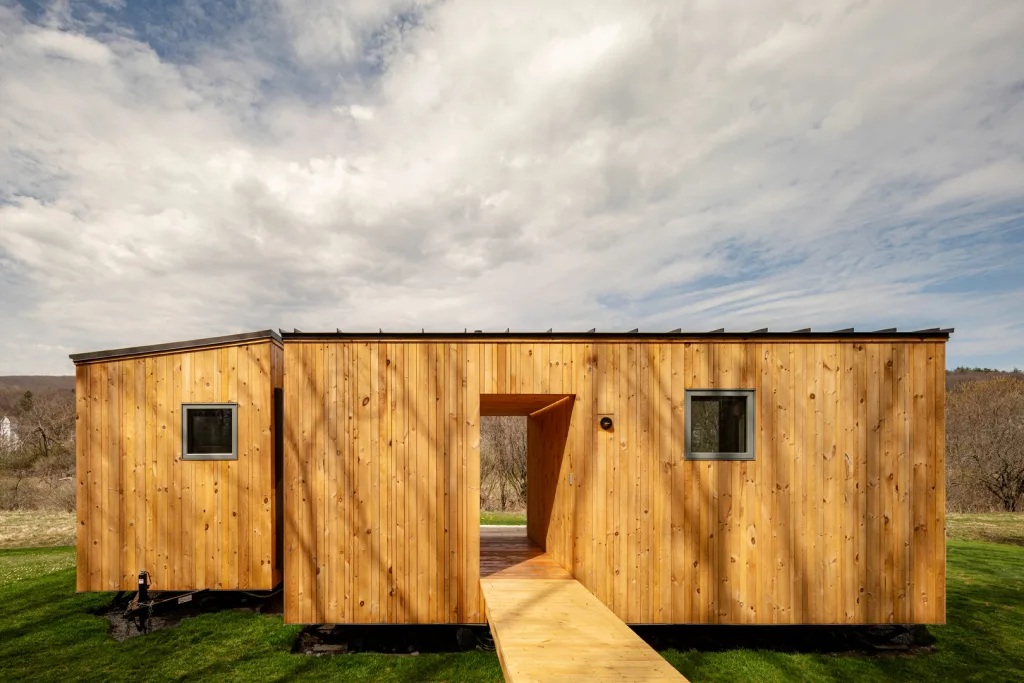These high-design cabins are a new take on tiny homes
The developer behind Tourists, a popular boutique hotel, designed a new kind of tiny home—and is manufacturing it in the U.S.
The next time you go on vacation, Ben Svenson wants you to consider staying in a tiny home, rather than a hotel. And he’s designed one so beautiful, you’ll have trouble saying no.
As a real estate developer, Svenson had come across tiny homes, which are typically between 100 and 400 square feet in size. He was intrigued by the modularity and movability of these structures, but he also thought they left a lot to be desired. “What if you sleep in a king-size bed?” he says. “Or what if you want a full-size shower?”
Over the past two decades, Svenson has taken on a wide array of projects. He bought a dilapidated motel in the Berkshires, transforming it into Tourists, one of the hottest hotels in the area. He bought the Blackinton Mill, a decaying factory near the hotel, with the view of potentially building a hotel there. Reimagining the tiny house as a more luxurious experience felt like a good next challenge.

During the pandemic, Svenson decided to give it a go. He partnered with Berkshire-based architects, engineers, and workshops to build different tiny home concepts. Some were elevated, like treehouses. Others relied on natural airflow and so could only be used for a few months in the summer.
This year, Svenson’s finally produced the prototype of his dream cabin. The sleek wooden structure, which is 280 square feet, has all the details you’d find in a high-end hotel, including a luxurious shower with a skylight, two separate bedrooms, a patio, and a kitchen with concrete countertops and custom-designed wood cabinetry. For now, guests can’t stay in it, but the hotel is organizing concerts and events in the cabin. The goal is to invite other hoteliers the chance to explore them, with the view of potentially ordering some for their own properties. Through a licensing model, Tourists will support other hoteliers who want to bring Tourists Cabins to their existing property, or build their own franchised hotel startup.

The Rise and Fall of the Berkshires
The Berkshires is a region in Western Massachusetts known for its idyllic landscapes and mountains. During the industrial revolution, it was a bustling economic hub, full of mills that produced wool and cotton.
But for the last century, as manufacturing moved off-shore, many towns in the area have fallen into blight. Wealthy vacationers from New York and Boston come in the summer for the culture. They visit the famous Massachusetts Museum of Contemporary Art and the Clark Art Institute, or attend musical performances at Tanglewood. The revenue they bring in hasn’t been enough to return the region to its former glory.
Svenson first fell in love with the Berkshires when he attended the Williamstown Theater Festival, a well-known annual event that attracts stars like Gwyneth Paltrow, Matthew Broderick, Audra McDonald, and Bradley Cooper. At the time, there wasn’t a stylish, modern hotel for the sophisticated visitors that came in from out of town to watch these plays. Svenson believed he could build one.
In 2018, he cofounded Tourists, which is in North Adams, just minutes from Williamstown. It’s a 48-room hotel, where each room offers a view of nearby forests or the Hoosic River. The architecture is minimal and inspired by the work of landscape architect Lawrence Halprin, who designed the utopian community of Sea Ranch in California. “We used his design principles,” says Svenson. “He said you should only use local materials and leave them unfinished because paint will eventually just seep into the Earth.”

After opening the hotel, Svenson decided to move his family to Williamstown to stay embedded in the local community. And that’s when he began to understand exactly how badly the region had been impacted by the forces of globalization. “There was such a wealth of knowledge and craftsmanship in this region,” he says. “Our country is not fully utilizing these resources today.”

The Blackinton Woolen Mill, for instance, was a beautiful factory built in 1822 that had produced cloth for decades, including the uniforms for the Union Army, before it shuttered in 1950. Svenson decided to buy this property, with the view of possibly turning it into another hotel. But now, he has another idea for it.

A Tiny Home Boom
In the midst of the pandemic, Svenson noticed that one factory in North Adams that made tiny houses was doing a lot of business. This made sense. Tiny homes were gaining steam around the country. Glamping chains like Getaway invited guests to stay in tiny houses in the wilderness. “This factory was creating several tiny houses a week, all made using American labor and largely American materials,” he says.
Svenson was intrigued. And as someone with an eye for design, he liked the idea of elevating the design of a tiny home to create the kind of high-end experience one of his own hotel guests might appreciate. So he reached out to Mandy Johnson and James Jarzyniecki of North Adams-based JZJN, who had done projects for local museums. Together, they developed the look of the cabins, which feature a 360-degree view of the surroundings. The goal was to allow guests to commune with nature, while also giving them the privacy.

The team built the cabins in North Adams, tapping into the expertise of local craftspeople. But his hope is to start making them at scale, to bring life back into local factories. And as it happened, he had the perfect space for this project. His new vision is to transform the Blackinton Mill into a manufacturing hub for the cabins he’s developed.

Today, Tourists unveils the cabins that sit on the property and look out into the wilderness. Right now, Tourists is doing programming around the cabin, including an outdoor music series, so people can experience the space firsthand.
The long-term goal is to start manufacturing these cabins for other hoteliers, using a licensing model. It will give entrepreneurs a way to launch their own hotel startup, with Tourists’ backing and support. And existing hotel owners can add more capacity to their properties to help them compete with bigger chains. “As the owner of a boutique hotel, I understand how space-constrained we are,” he says. “It’s hard to compete with larger hotels that have more capacity that they can open up during peak seasons.”

Through the franchise model, Tourists would share revenue that comes in from guests. The experience would be called “Tourists Cabins” and have the same branding as the main Tourists hotel. “I can imagine these cabins all over the country,” he says. “You could experience Tourists in Montana or California.”

Through mass manufacturing, Svenson can get the pricing of these units down to around $200,000 for a cabin with two parts, one for the bedrooms and the other for the kitchen and bathroom. But it is possible to add another section to create a living area, an additional full-size bed, a custom sofa, a half bath, and a full-size washer and dryer.
Ultimately, the thing that Svenson is most excited about is how much work this could generate back home in the Berkshires. The Blackinton Mill, which has been vacant for three quarters of a century, would come back to life. “We’ll be able to bring manufacturing back to this community,” he says.
ABOUT THE AUTHOR
(16)
Report Post







